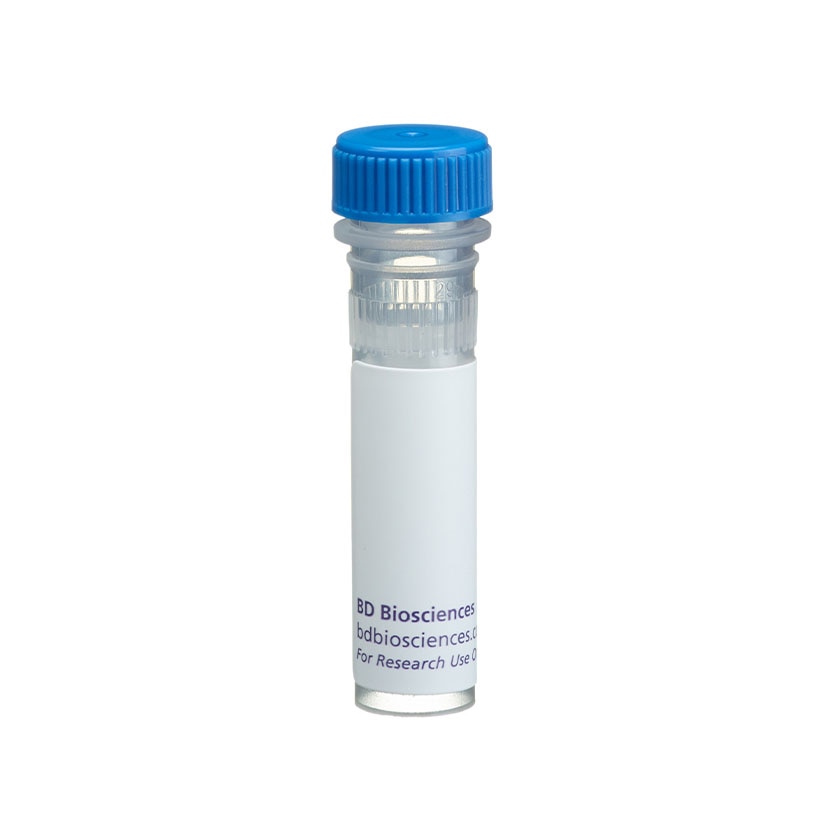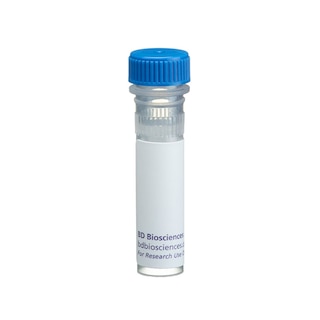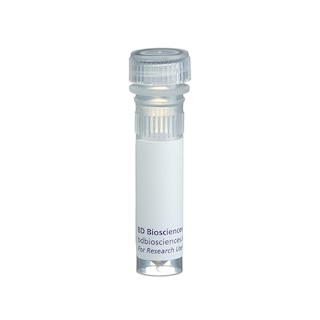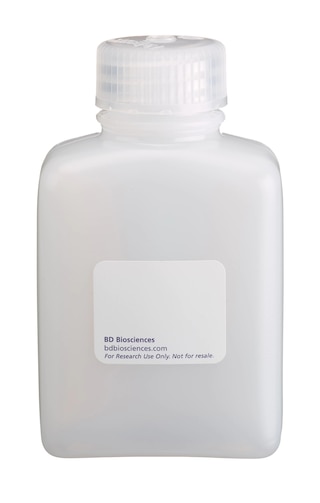-
Reagents
- Flow Cytometry Reagents
-
Western Blotting and Molecular Reagents
- Immunoassay Reagents
-
Single-Cell Multiomics Reagents
- BD® OMICS-Guard Sample Preservation Buffer
- BD® AbSeq Assay
- BD® Single-Cell Multiplexing Kit
- BD Rhapsody™ ATAC-Seq Assays
- BD Rhapsody™ Whole Transcriptome Analysis (WTA) Amplification Kit
- BD Rhapsody™ TCR/BCR Next Multiomic Assays
- BD Rhapsody™ Targeted mRNA Kits
- BD Rhapsody™ Accessory Kits
- BD® OMICS-One Protein Panels
- BD OMICS-One™ WTA Next Assay
-
Functional Assays
-
Microscopy and Imaging Reagents
-
Cell Preparation and Separation Reagents
Old Browser
This page has been recently translated and is available in French now.
Looks like you're visiting us from {countryName}.
Would you like to stay on the current location site or be switched to your location?
BD Pharmingen™ Purified Mouse Anti-Human CD152
Clone BNI3 (RUO)

Immunohistochemical staining of CTLA-4 positive cells. Frozen section of normal human tonsil was stained with Purified Mouse Anti-Human CD152 (Cat. No. 550405), and visualized with Biotin Goat Anti-Mouse Ig (Multiple Adsorption) (Cat. No. 550337), Streptavidin HRP (Cat. No. 550946), and DAB Substrate Kit (Cat. No. 550880). Activated T- and B-lymphocytes positive for CTLA-4 can be identified by the intense brown labeling of their cell membranes. Amplification 40X.


Immunohistochemical staining of CTLA-4 positive cells. Frozen section of normal human tonsil was stained with Purified Mouse Anti-Human CD152 (Cat. No. 550405), and visualized with Biotin Goat Anti-Mouse Ig (Multiple Adsorption) (Cat. No. 550337), Streptavidin HRP (Cat. No. 550946), and DAB Substrate Kit (Cat. No. 550880). Activated T- and B-lymphocytes positive for CTLA-4 can be identified by the intense brown labeling of their cell membranes. Amplification 40X.

Immunohistochemical staining of CTLA-4 positive cells. Frozen section of normal human tonsil was stained with Purified Mouse Anti-Human CD152 (Cat. No. 550405), and visualized with Biotin Goat Anti-Mouse Ig (Multiple Adsorption) (Cat. No. 550337), Streptavidin HRP (Cat. No. 550946), and DAB Substrate Kit (Cat. No. 550880). Activated T- and B-lymphocytes positive for CTLA-4 can be identified by the intense brown labeling of their cell membranes. Amplification 40X.



Regulatory Status Legend
Any use of products other than the permitted use without the express written authorization of Becton, Dickinson and Company is strictly prohibited.
Preparation And Storage
Recommended Assay Procedures
Immunohistochemistry: The BNI3.1 clone reactive against human CD152 is tested for immunohistochemical staining of acetone-fixed frozen sections. Tissue tested was human spleen and tonsil. The antibody stains activated T- and B-lymphocytes. The isotype control recommended for use with this antibody is purified mouse IgG2a (Cat. No. 550339). For optimal indirect immunohistochemical staining, the BNI3.1 antibody should be titrated (1:10 to 1:50 dilution) and visualized via a three-step staining procedure in combination with polyclonal, biotin conjugated anti-mouse Igs (multiple adsorbed) (Cat. No. 550337) as the secondary antibody and Streptavidin-HRP (Cat. No. 550946) together with the DAB detection system (Cat. No. 550880).
Product Notices
- Please refer to www.bdbiosciences.com/us/s/resources for technical protocols.
- Since applications vary, each investigator should titrate the reagent to obtain optimal results.
- An isotype control should be used at the same concentration as the antibody of interest.
- Source of all serum proteins is from USDA inspected abattoirs located in the United States.
- Caution: Sodium azide yields highly toxic hydrazoic acid under acidic conditions. Dilute azide compounds in running water before discarding to avoid accumulation of potentially explosive deposits in plumbing.
- This antibody has been developed for the immunohistochemistry application. However, a routine immunohistochemistry test is not performed on every lot. Researchers are encouraged to titrate the reagent for optimal performance.
- Species cross-reactivity detected in product development may not have been confirmed on every format and/or application.
- Sodium azide is a reversible inhibitor of oxidative metabolism; therefore, antibody preparations containing this preservative agent must not be used in cell cultures nor injected into animals. Sodium azide may be removed by washing stained cells or plate-bound antibody or dialyzing soluble antibody in sodium azide-free buffer. Since endotoxin may also affect the results of functional studies, we recommend the NA/LE (No Azide/Low Endotoxin) antibody format, if available, for in vitro and in vivo use.
- Please refer to http://regdocs.bd.com to access safety data sheets (SDS).
- For U.S. patents that may apply, see bd.com/patents.
Companion Products






The BNI3 monoclonal antibody specifically binds to the human cytolytic T lymphocyte-associated antigen (CTLA-4), also known as CD152. CTLA-4 is transiently expressed on activated CD28+ T cells and binds to CD80 and CD86 present on antigen presenting cells (APC) with high avidity. This interaction appears to deliver a negative regulatory signal to the T cell. Recent reports indicate that CTLA-4 is also expressed on B cells when cultured with activated T cells, suggesting a role for CTLA-4 in the regulation of B-cell response. Immobilized BNI3 antibody enhances T-cell proliferation induced by antibody-mediated crosslinking of CD3 and CD28. Recent studies have shown that CD152 can be expressed by regulatory T (Treg) cells. After cellular fixation and permeabilization, the BNI3 antibody can stain intracellular CD152 expressed in T cells including Treg cells. Clone BNI3 was studied in the VI Leukocyte Typing Workshop.
Development References (10)
-
Cabezon R, Sintes J, Llinas L, Benitez-Ribas D. Analysis of HLDA9 mAbs on plasmacytoid dendritic cell. Immunol Lett. 2011; 134(2):167-173. (Clone-specific: Flow cytometry). View Reference
-
Castan J, Klauenberg U, Kalmar P, Fleischer B, Broker BM. Expression of CTLA-4 (CD152) on human medullary CD4+ thymocytes. Med Microbiol Immunol (Berl). 1998; 187(1):49-52. (Immunogen: Fluorescence microscopy, Immunocytochemistry, Immunofluorescence, Immunohistochemistry). View Reference
-
Castan J, Tenner-Racz K, Racz P, Fleischer B, Broker BM. Accumulation of CTLA-4 expressing T lymphocytes in the germinal centres of human lymphoid tissues. Immunology. 1997; 90(2):265-271. (Immunogen: ELISA, Fluorescence microscopy, Immunofluorescence, Immunohistochemistry). View Reference
-
Healy ZR, Murdoch DM. OMIP-036: Co-inhibitory receptor (immune checkpoint) expression analysis in human T cell subsets.. Cytometry A. 2016; 89(10):889-892. (Clone-specific: Intracellular Staining/Flow Cytometry). View Reference
-
Kuiper HM, Brouwer M, Linsley PS, van Lier RA. Activated T cells can induce high levels of CTLA-4 expression on B cells. J Immunol. 1995; 155(4):1776-1783. (Biology). View Reference
-
Lindsten T, Lee KP, Harris ES, et al. Characterization of CTLA-4 structure and expression on human T cells. J Immunol. 1993; 151(7):3489-3499. (Biology). View Reference
-
Morton PA, Fu XT, Stewart JA, et al. Differential effects of CTLA-4 substitutions on the binding of human CD80 (B7-1) and CD86 (B7-2). J Immunol. 1996; 156(3):1047-1054. (Biology). View Reference
-
Rabe H, Lundell AC, Andersson K, Adlerberth I, Wold AE, Rudin A. Higher proportions of circulating FOXP3+ and CTLA-4+ regulatory T cells are associated with lower fractions of memory CD4+ T cells in infants.. J Leukoc Biol. 2011; 90(6):1133-40. (Clone-specific: Intracellular Staining/Flow Cytometry). View Reference
-
Santegoets SJ, Dijkgraaf EM, Battaglia A, et al. Monitoring regulatory T cells in clinical samples: consensus on an essential marker set and gating strategy for regulatory T cell analysis by flow cytometry.. Cancer Immunol Immunother. 2015; 64(10):1271-86. (Clone-specific: Intracellular Staining/Flow Cytometry). View Reference
-
Wang H, Shih CC, Waters JB, et al. CD152 (CTLA4) Workshop: Expression and function of CD152 on human T cells: A study using a mouse anti-human CD152 monoclonal antibody BNI3.1. In: Kishimoto T. Tadamitsu Kishimoto .. et al., ed. Leucocyte typing VI : white cell differentiation antigens : proceedings of the sixth international workshop and conference held in Kobe, Japan, 10-14 November 1996. New York: Garland Pub.; 1997:97-98.
Please refer to Support Documents for Quality Certificates
Global - Refer to manufacturer's instructions for use and related User Manuals and Technical data sheets before using this products as described
Comparisons, where applicable, are made against older BD Technology, manual methods or are general performance claims. Comparisons are not made against non-BD technologies, unless otherwise noted.
For Research Use Only. Not for use in diagnostic or therapeutic procedures.